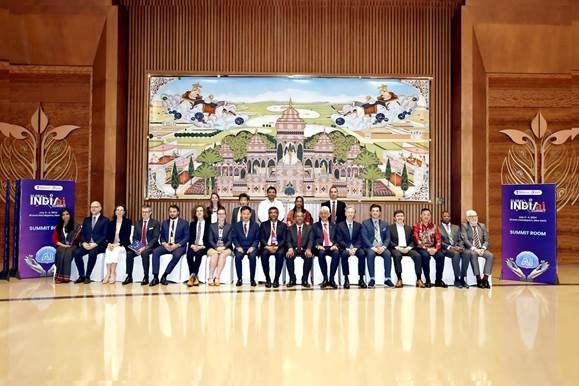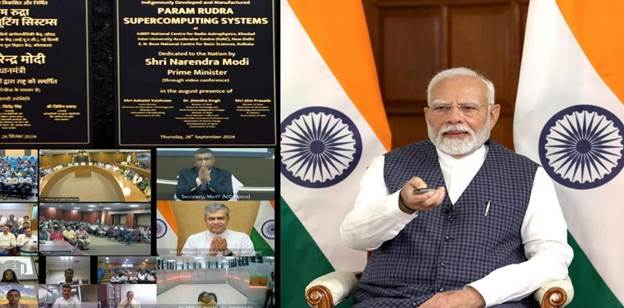Ministry of Electronics & IT
Year End Review 2024 of Ministry of Electronics & Information Technology Part-1
Government of India approved four (4) semiconductor manufacturing units in India under Semicon India Programme
India takes the lead in Global Partnership on Artificial Intelligence (GPAI) by hosting 6th meeting of the GPAI Ministerial Council in New Delhi; Set to be outgoing chair in 2025
9 projects under Scheme for Promotion of Manufacturing of Electronic Components and Semiconductors (SPECS) approved by government; To generate 15,710 Jobs
6.39 crore individuals trained under Pradhan Mantri Gramin Digital Saksharta Abhiyan (PMGDISHA) exceeding the target of 6 crore
Skill Development training undertaken for 18,209 SC/ST & EWS (Women) youth across 81 Aspirational Districts to make them reliable for employment and entrepreneurship
With 50+ Stakeholders onboard, BHASHINI bridging language barriers for accessible digital services with with 100 million+ Inferences per month; Translation services available in 22 scheduled Indian languages
Prime Minister of India launched three (3) PARAM Rudra supercomputers to strengthen research & innovation in India; Physics, earth sciences, and cosmological studies to get a boost
Posted On:
27 DEC 2024 9:52AM by PIB Delhi
In 2024, the Ministry of Electronics and Information Technology (MeitY) led key initiatives to advance India’s digital growth, focusing on AI, cybersecurity, and skill development. These efforts aim to make technology more accessible, boost innovation, and strengthen India’s position on the global tech stage.

Semiconductor manufacturing under Semicon India Programme
-
Tata Electronics Private Limited (TEPL)’s proposal for setting up a Semiconductor Fab facility in India with an investment of ₹91,526 Crore was approved in February 2024. The fab facility will be set up in a technology partnership with PSMC, Taiwan. PSMC is an established semiconductor company having 6 semiconductor foundries in Taiwan. The production capacity of the project would be around 50,000 wafer starts per month (WSPM).
-
Tata Electronics Private Limited (TEPL)’s proposal for setting up of OSAT facility in India with an investment of ₹27,120 Crore was approved in February 2024. The facility will use indigenous semiconductor packaging technologies with a production capacity of 48 million per day.
-
CG Power and Industrial Solutions Limited’s proposal for setting up an OSAT facility in India with an investment of ₹7,584 Crore was also approved in February 2024. The facility will be set up as a joint venture partnership with Renesas Electronics America Inc., USA, and STARS Microelectronic, Thailand. The Technology would be provided for this facility by Renesas Electronics Corporation, Japan and STARS Microelectronic, Thailand. The production capacity would be around 15.07 million Units per day.
-
Kaynes Technology India Limited (KTIL) proposal for setting up of Outsourced Semiconductor Assembly and Test (OSAT) facility at Sanand, Gujarat for Wire bond Interconnect, Substrate Based Packages was approved in September, 2024. The Technology would be provided by ISO Technology Sdn. Bhd. and Aptos Technology Inc. This facility will be set up with an investment of ₹3,307 Crore. The facility will have the capacity to produce more than 6.33 million chips per day.
IndiaAI Mission
-
Design, Development, and Deployment of National AI Portal (INDIAai)
INDIAai is a joint venture by MeitY, NeGD and NASSCOM that has been set up to prepare the nation for an AI future. This has been implemented as a one stop online portal for AI related developments in India, sharing of resources, details of start-ups, investment funds in AI, companies and educational institutions related to AI in India, etc.
The portal currently has the following major sections – news, articles, case studies, research reports, listing of startups, listing of investment funds, colleges, companies, countries, people, videos, datasets, courses, and initiatives of states and central ministries.
As on date, there are 2,806 national and international articles, 1,175 news, 334 videos, 164 research reports, 472 startups, 99 case studies, and 184 government initiatives listed on the National AI Portal.
-
POC for AI Research Analytics and Knowledge Dissemination Platform (AIRAWAT)
The Government has initiated a project AIRAWAT for providing a common compute platform for AI research and knowledge assimilation. This AI computing infrastructure will be used by all Technology Innovation Hubs, research labs, scientific community, industry, start-ups and institutions under the National Knowledge Network. The Proof of Concept (PoC) for AIRAWAT will be developed with 200 petaflops mixed precision AI machine which will be scalable to a peak compute of 790 AI petaflops.
The AIRAWAT has secured 75th position in Top 500 Global Supercomputing List declared at International Supercomputing Conference (ISC 2023), Germany putting India on top of AI Supercomputing nations worldwide.
-
Formation of Inter-Ministerial Committee for Development of Robotics Ecosystem in the country
MeitY has constituted an inter-ministerial committee with secretaries from Department of Telecom (DoT), Department of Scientific and Industrial Research (DSIR), Department of Science & Technology (DST), Department for Promotion of Industry and Internal Trade (DPIIT) and NITI Aayog as members and Secretary, MeitY as the convener.
The committee shall be studying the best practices on the role of government in supporting their domestic robotics industry & suggest a way forward to foster an end-to-end ecosystem centred on robotics including research, design, manufacturing, prototyping and utilization in manufacturing. The document has been put up for public consultation.
-
National Program on Artificial Intelligence
IndiaAI program is envisioned as an umbrella programme by MeitY for leveraging transformative technologies to foster inclusion, innovation, and adoption for social impact. Pillars of IndiaAI include Data for AI, Skilling, AI Ethics and Governance, Compute, AI Research and Development, National Centre for AI, among others.
To actualize this vision of IndiaAI, MeitY has undertaken the implementation of the “National Program on Artificial Intelligence” with the objective of establishing a comprehensive programme for leveraging transformative technologies to foster inclusion, innovation and adoption for social impact. It encompasses four broad pillars of the AI ecosystem, including Skilling in AI, Responsible AI, Data Management Office and the National Centre on AI.
-
IndiaAI Report
MeitY envisions the India AI programme as a mission-centric approach for leveraging transformative technologies to boost inclusion, innovation, and adoption for social impact. Pillars of IndiaAI include AI in Governance, AI IP & Innovation, AI Compute & Systems, Data for AI, Skilling in AI, and AI Ethics & Governance. As part of building ‘AI in India and AI for India’, MeitY has formed seven expert groups to collaboratively brainstorm on the vision, objectives, outcomes, and design for each of India's AI pillars.
The report comprehensively presents the objectives of the pillars of IndiaAI and recommends the next action items involved in harnessing the potential of AI for social development and achieving the goal of ‘AI for ALL’.
Global Partnership on Artificial Intelligence (GPAI)
As one of the largest Global South economies leading the AI race, India nominated itself for the position of incoming council chair of GPAI. India received more than two-thirds of first-preference votes and was therefore elected as the Incoming Council Chair in November 2022. India will serve as the Incoming Chair in 2023, then subsequently Lead Chair in 2024, and Outgoing Chair in 2025.
The 6th meeting of the GPAI Ministerial Council was held on 3rd July 2024 at Bharat Mandapam, New Delhi in a hybrid mode.

The 2024 GPAI New Delhi meeting and the consensus reached on the future of GPAI underscores India's leadership in the global AI discourse, cementing its pivotal role in steering the ethical and inclusive development of AI. This will pave the way for the renewed integrated partnership to achieve its objectives of harnessing the potential of AI for Good and for All. (https://gpai.ai/)
Modified Electronics Manufacturing Clusters (EMC 2.0) Scheme
-
EMC Scheme 2.0
With the approval of the union Cabinet, MeitY notified EMC 2.0 Scheme on 01.04.2020 to provide financial assistance for creation of industry-oriented infrastructure along with common facilities and amenities including plug & play facilities for attracting major electronics manufacturers along with their supply chain to set up their manufacturing facility through such clusters.
The Scheme was open for receipt of application for a period upto March, 2024 with disbursement of funds upto March, 2028 to the approved projects.
The following projects have been granted approval since January 2024 till date:
-
A CFC project (one of the largest prototyping facilities) at Hyderabad knowledge City, Telangana to be implemented by M/s T-Works Foundation with a project cost of ₹104.63 Crore including Central Grant-in-aid of ₹75.00 Crore to provide one stop solution to industry from designing, engineering, prototyping to testing and validation etc.
-
An EMC (New Energy Park) at Divtipally Village, Mahabubnagar District, Telangana over an area of 377.65 acres to be developed by M/s Telangana Industrial Infrastructure Corporation Limited (TGIIC) with a project cost of ₹569.66 Crore including Central Grant-in-aid of ₹258.10 Crore. This electronics park is fully occupied and attracted an investment of ₹10,574 Crore with estimated employment of 19,164 persons. The total value of production in Divitipally EMC is estimated to be ~₹22,500 Crore with estimated exports of over ₹4,500 Crore once fully operational.
-
M/s State Industries Promotion Corporation of Tamil Nadu (SIPCOT) accorded approval on 13.11.2024 for EMC establishment over an area of 379.30 acres at Pillaipakkam Village, Sriperumbudur Taluk, Kancheepuram District, Tamil Nadu with project cost of ₹424.55 Crore including Central financial assistance of ₹212.27 Crore. This EMC is poised to attract an investment of ₹8,737 Crore with employment generation of 36,300 persons.
The EMC is 66% occupied with allotment to 4 companies including one of the US firms i.e., M/s First Solar, which has started production with investment of ₹4,941 Crore and provided employment to 1,463 persons.
-
M/s Karnataka Industrial Areas Development Board (KIADB) accorded approval on 14.11.2024 for EMC establishment over an area of 235.55 acres at Kochanahalli village, Mysuru district, Karnataka with a project cost of ₹221.54 Crore including Central Grant-in-aid of ₹110.77 Crore. This EMC is poised to attract an investment of ₹1,560 Crore with employment generation of 19,500 persons. 3 companies have already committed to make an investment of ₹1,591 Crore with employment generation of 2,490 persons.
-
Government has approved 9 projects for electronic components manufacturing under the Scheme for Promotion of Manufacturing of Electronic Components and Semiconductors (SPECS) with a total proposed investment of ₹7,960 Crore. The total employment generation potential of these applications is 15,710 persons. The major applications include M/s Tata Electronics Private Limited, M/s TDK India Private Limited, M/s Motherson Electronic Components Private Limited and M/s Bharat Innovative Glass Technologies Private Limited.
Capacity Building
The Pradhan Mantri Gramin Digital Saksharta Abhiyan (PMGDISHA) was initiated to reach digital literacy in 6 crore rural households (one person per household) nationwide in Feb. 2017.
The National Sample Survey Office (NSSO) conducted the ‘Comprehensive Annual Modular Survey’ (CAMS) in its 79th round (July, 2022 to June, 2023) and the data in their report indicated a significant positive trend in digital literacy across both rural and urban areas of India. As against 6 Crore, 6.39 Crore individuals were trained across the country as on March 31, 2024, the scheme has ended. From the above reports and given the significant rise in smart-phone usage, internet penetration, and digital engagement in rural areas, the objectives of the scheme have been successfully achieved.
Further, the Government has approved the following two schemes for Skill Development in Electronics System Design and Manufacturing (ESDM) Sector viz. “Scheme for Financial Assistance to select States/UTs for Skill Development in ESDM Sector” (Scheme-1) and “Skill Development in ESDM for Digital India” (Scheme-2) to facilitate creation of an ecosystem for development of ESDM Sector in the entire country. Cumulative skilling target of both the Schemes is 4,18,000 candidates (Scheme 1-90,000 and Scheme 2 - 3,28,000) through NSQF compliant courses at L1 to L5 levels.
In order to support industry requirements in assembly and manufacturing in the area of core technology and futuristic technology, a total 99 National Skills Qualifications Framework (NSQF) aligned courses (core technology course-61 and futuristic Technology Course-38) have been approved under the Schemes. Total, 320 industries have participated in industry-linked demand-based LOIs (Letter of Intent) mechanisms, i.e., the “Place & Train” model. As against the cumulative target of 4,18,000 candidates under the said schemes, 4,93,926 have been trained, out of which, 3,71,113 candidates have been certified and around 1,36,059 candidates have been placed under the Schemes.
IT for Masses Programme, part of the Capacity Building and Skill Development scheme, seeks to bridge the Digital Divide by fostering ICT activities for focus groups such as women, Scheduled Castes (SC), Scheduled Tribes (ST), senior citizens, specially-abled individuals, and those from economically weaker sections (EWS), as well as for underserved areas including the North-Eastern Region, backward districts and blocks, and districts with over 40% SC/ST population. The programme promotes inclusive IT sector growth through infrastructure development, training, capacity building, and entrepreneurship activities. From F.Y. 2006-07 onwards, MeitY has funded 124 projects across India which have benefitted directly about 5.56 lakh women and 1.12 lakh SCs & 0.59 lakh STs.
Cyber Security for resilient digital landscape in India
As part of the Cyber Surakshit Bharat (CSB) programme, MeitY conducted the 45th batch of Chief Information Security Officer (CISO) Deep Dive training .This initiative aimed at equipping CISOs and IT officials from government sectors, PSUs, and financial institutions with essential cybersecurity skills and strengthening India's digital security. CERT-In has also made significant progress by onboarding 388 organizations to the Cyber Swachhta Kendra and holding a cybersecurity drill for the health sector.
Digital India BHASHINI: Language translation Platform
BHASHINI aims to transcend language barriers, ensuring that every citizen can effortlessly access digital services in their own language. Using Voice as a medium, BHASHINI has the potential to bridge language as well as the digital divide. Launched by Honourable PM in July 2022 under the National Language Technology Mission, BHASHINI aims to provide technology translation services in 22 scheduled Indian languages.17 Indian languages are supported.

Key Achievements:
-
100 million+ Inferences per Month: Bhashini has successfully crossed the 100 million monthly inferences threshold, demonstrating its growing reach and impact in the AI language technology sector.
-
50+ Stakeholders Onboarded: Over 50 stakeholders, including prominent government bodies (NPCI, RBIH, MoRD, Lok Sabha, Rajya Sabha, etc.) and private sector partners, are now collaborating with Bhashini.
-
700,000+ Mobile App Downloads: The Bhashini-powered mobile apps have been downloaded more than 500,000 times, showing widespread adoption and accessibility.
-
100+ Use Cases: Bhashini supports over 100 diverse use cases, showcasing the platform's adaptability across industries and sectors.
-
17 Languages Supported: Bhashini currently supports 17 Indian languages, enabling inclusivity for a broad range of linguistic communities.
-
300+ AI-Based Models: The platform hosts over 300 AI-based language models, furthering the development of state-of-the-art solutions in the AI language technology space.
Awards and Recognition
-
Bhashini's contributions have been recognized across various forums, showcasing leadership in AI, digital transformation, and inclusivity. The awards and recognitions include:
-
Digital Trailblazer Award by Express Computer: Outstanding contributions to the AI ecosystem in India.
-
Elets AtmaNirbhar Award: Awarded under the category of Digital Governance for AI, ML, and IoT initiatives by government departments.
-
Impact Leader of the Year: Global Spin Innovation Summit 2024.
-
Leadership in AI, Change Maker & Innovation Award: Recognizing excellence in AI-driven innovation and leadership.
-
ET Government Award for AI, Data Analytics & Predictive Technologies: Recognized for bridging the literacy, language, and digital divides.
-
Elets Education Innovation Award: For providing accessible & inclusive education through AI.
National Supercomputing Mission (NSM)
On 26th September, Hon’ble Prime Minister dedicated three PARAM Rudra Supercomputers to the nation via video conferencing. These supercomputers, developed under the NSM, are installed at the Inter-University Accelerator Centre (IUAC) in New Delhi (3 PetaFlops), the Giant Metrewave Radio Telescope (GMRT) at the National Centre for Radio Astrophysics (NCRA) in Pune (1 PetaFlop), and the S. N. Bose National Centre for Basic Sciences in Kolkata (838 TeraFlops).

-
These supercomputers are built using indigenously designed and manufactured High Performance Computing servers, known as "Rudra," along with a locally developed software stack. The PARAM Rudra Supercomputers will significantly enhance research capabilities for young scientists in India, facilitating advanced studies in physics, earth sciences, and cosmology.
-
With the commissioning of the above three PARAM Rudra supercomputers, as of now, a total of 33 supercomputers with a combined compute capacity of 32 Petaflops, have been deployed across various academic institutions, research organizations, and R&D labs, including prominent institutions like IISc, IITs, C-DAC, and other institutions from Tier-II and Tier- III cities of the country under NSM.
-
These supercomputers facilitate over 10,000 researchers, including more than 1,700 PhD scholars from over 200 academic institutions and R&D labs across the country. NSM has created opportunities for researchers from Tier-II and Tier-III cities to conduct research by providing access to state-of-the-art supercomputing facilities.
*****
Dharmendra Tewari/Kshitij Singha
(Release ID: 2088268)
Visitor Counter : 7555